automatic weapons
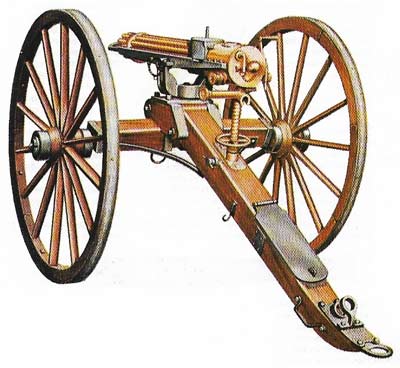
Figure 1. The Gatling gun appeared in many versions. The most widely used had 10 barrels, which fired 0.45-inch bullets at a rate of 1,000 rounds per minute (rpm). But this rate of fire could be maintained for a few seconds only, because the gun needed to be reloaded frequently.
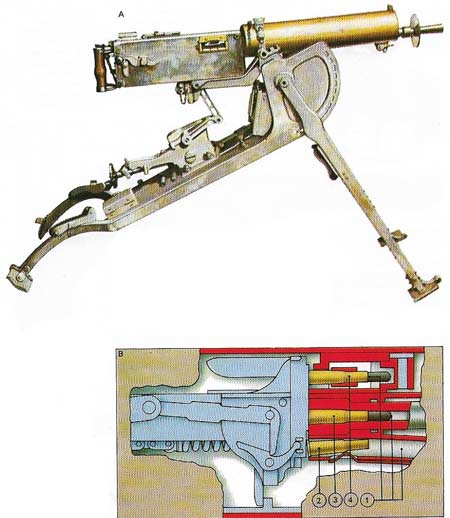
Figure 2. The Maxim gun (A), a widely used and much copied weapon, had various calibers and reached 450 rpm. When tested against the Gatling in Germany it fired 333 rounds in 30 seconds with one man, while the four-man Gatling crew took twice as long to do the same. The cutaway section (B) shows (1) the gun's three chambers, (2) spent cartridge case, (3) cartridge and bullet in firing position, (4) next cartridge and bullet ready for loading.
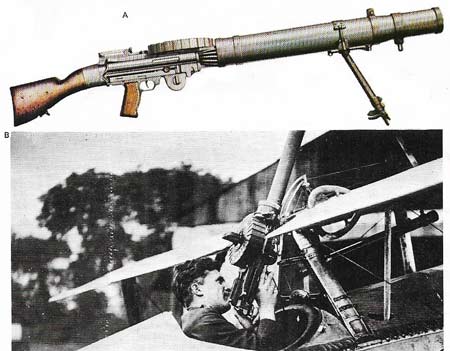
Figure 3. The Lewis gun (A) was the most successful light machinegun of World War I; more than 100,000 were produced for the Allied armies. Unloaded it weighed 11.8 kilograms (26 pounds); it was 128 centimeters (50.5 inches) long and held a 47- or 97-round pan magazine firing 550 rounds per minute. It could be made more quickly and cheaply than any similar gun, could be carried and operated by one man, and used the same .303-inch ammunition as infantry rifles. Isaac Newton (1858–1931), a US Army colonel, had developed the gun in 1911, but it was first used by the Belgians in 1914 and soon after by the British. It was also widely used o aircraft, being first installed on pusher biplanes. When used in single-seat tractor aircraft the Lewis was mounted on a quadrant on the top wing (B) so that the pilot could pull it down to change the drum. Since aerial gun-aiming was imprecise the Lewis, relatively inaccurate, gave an effective "spray" of bullets.
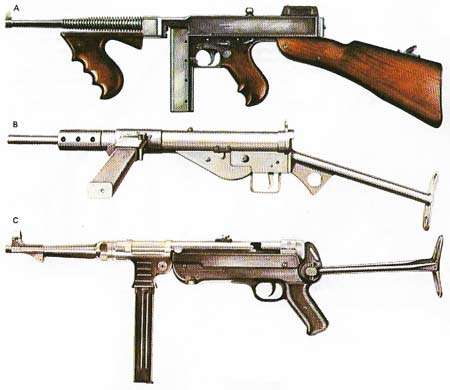
Figure 4. Sub-machine guns proved their worth in World War II. The Thompson (A), built by Colt, was a good weapon but expensive. It was replaced by the Sten (B). More than 2 million of these were produced at a cost of £1.50 each. The German Erma MP 40 (C), like the Sten, was made largely from stamped-out parts; only the barrel and breach were precision made. Many regarded it as the best light machine gun of the war.
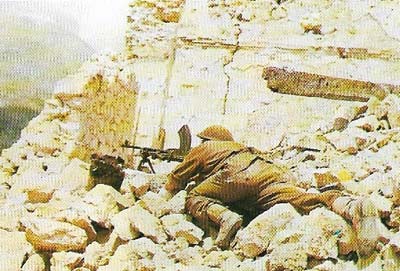

Figure 5. The Bren was highly regarded and is still in service today (A). Built by the Royal Small Arms Enfield factory from a Czech design, the Bren was a good light machine gun and standard equipment in nearly all the Allied armies. The mechanism (B) is gas-operated. Gas from the barrel (1) drives back the piston (2) and the breech block, which ejects the empty case and then, as it is driven forward again by the return spring(6), picks up a new round (3). The hammer (4) then hits the end of the firing pin (5) and fires the round. The volume of gas in the chamber (7) is controlled by a gas regulator (8).
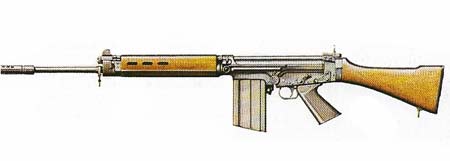
Figure 6. The Belgian FN was adopted as the standard NATO rifle in the 1950s. It can be used as a single-shot weapon or as an automatic and fires that standard 7.62-millimeter round. The operation of the gun is simplified because the left hand works the cocking, feed, and safety while the right hand is left to hold and fire the gun. Like the Bren, the FN is gas-operated, but its 20-round magazine is mounted underneath the gun. The gun is self-loading and fully waterproof and is one of the best infantry weapons in the world. It has a maximum rate of 600 rpm.
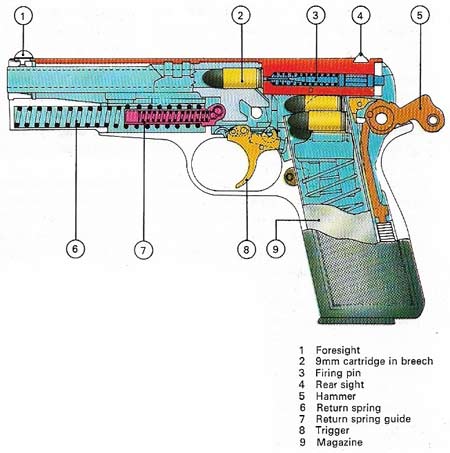
Figure 7. The Browning FN pistol, weighing just over 900 grams (2 pounds), was widely issued in World War II as the standard British automatic pistol. It carried 13 9-millimeter rounds in a magazine in the butt, an advantage over the usual 6-shot revolver. But its accurate range of 46 meters (150 fet) is no better than that of the revolver. With both weapons, accuracy depends principally on who is behind the gun. Strictly speaking, this and similar weapons are semi-automatic.
An automatic weapon is a gun, rifle, or pistol that fires continuously without any external aid such as hand-cranking (or even electric power) for as long as the trigger is pressed. Early designs were hand-cranked in one way or another, but they laid the framework for the first true automatic designs.
Early American designs
The best known early mechanical weapon was the Gatling (Figure 1), developed by the American inventor Richard Gatling (1818–1903) and first demonstrated in 1863. This used six barrels rotated by a hand crank and for 50 years the design was sold and copied throughout the world using a wide variety of calibers (barrel sizes). Later true automatic weapons used electric motors or gas pressure taken from the barrel. In the blowback action, part of the explosive force propelling the bullet ejects the spent cartridge and re-cocks the firing mechanism. In a gas-operated weapon hot gases led from the barrel force back a piston that works the ejection and re-cocking mechanisms.
Another American design was the Lowell gun, produced in 1875. This was also a hand-cranked weapon but one that overcame the heating problem affecting all machine guns after 300 or 400 rounds (bullets) have been fired, when the barrel becomes too hot for further use. It had four barrels, one of which was used at a time. When this became too hot a new barrel was rotated into position.
The next development came from another American, Hiram Maxim (1840–1916). He designed an automatic weapon (Figure 2) in London, starting by modifying a Winchester rifle. He used a hook fixed to the barrel to lock the bolt in place for firing. The recoil drove both hook and bolt back until the hook was lifted by passing under a bridge. The bolt continued back, driving round a crank to extract and reload the cartridge and was then forced back by a spring. Ammunition was fed into the gun by means of a belt, which could be joined to successive belts to provide continuous feed for long periods of firing.
Satisfied with the success of this design, Maxim simplified it and set up a company to produce the gun with Vickers, the shipbuilding company. Demonstrations in Europe impressed everybody who saw the gun in action. Vickers eventually took over the company and developed an improved version of the Maxim, which became the standard machine gun for many years.
As designs proliferated three main mechanisms came into use: blowback, recoil (as in the Maxim) and gas-operation. With the recoil method, the breech is locked to the barrel and they move back as one to start the cycle of extraction, ejection, cocking, feeding, chambering, locking and firing again.
World War II
By the start of World War II machine guns were grouped into three main types: the light machine gun such as the Bren (Figure 5), which can quickly be set up and fired; the medium machine gun such as the Vickers, capable of sustained fire but of necessity heavier and more robust; and the heavy machine gun used against aircraft and similar targets. The differences between the types are, however, more tactical than technical. The light or sub-machine gun was not popular until it proved its worth in the war in the shape of the many excellent German weapons such as the Erma, numerous cheap and simple Russian weapons and the Sten and Thompson (Figure 4).
The Americans relied on massed fire-power from the Garand or M1 automatic rifle, described by General Patton (1885–1945) as "the best battle implement ever designed". This was a gas-operated rifle of great simplicity and reliability. It was augmented later by a shorter carbine for use by troops (other than front-line infantry), who found a full-size rifle a hindrance. This was the concept behind the Belgian FN automatic rifle (Figure 6) after the war.
Automatic pistols and later developments
"Automatic" pistols (strictly speaking, semi-automatic weapons) started to come into their own at the turn of the century (Figure 7). One of the best known – the 9-millimeter Luger —went into service in 1908. It was officially replaced by the Walther P38 in 1938, but remained in general use although, being a particularly well-made gun, it was dependent on the quality of the ammunition. The advantages of the automatic over the revolver was its more rapid rate of fire and larger magazine. But it was more likely than the simpler revolver to jam in dirty conditions. This is one of the crucial points in the designs of all weapons, particularly automatics. These guns have to be able to operate in extreme conditions without loss of efficiency.
With the coming of fighter planes, then bombers that needed to defend themselves, the machine gun took to the air. The Lewis gun, Spandau and Hotchkiss were used in World War I fighters, with eight 12.7-millimeter (0.5-inch) guns being mounted in fighters in the later stages of World War II, and up to 13 in the Flying Fortress bomber. Brownings were the most popular choice of Allied forces.
With the coming of fast fighters the target was often in range for only a split second and was generally heavier and stronger. Cannon (with explosive bullets) began to replace machine guns long before the war ended but the ultimate weapon for this purpose came with the development of the rotating-barrel Vulcan, which uses a similar principle to the Gatling for its phenomenal rate of fire.
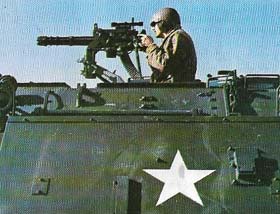 |
| The GEC Vulcan was designed for use in fighters in its 20-millimeter form. Later the 7.62-millimeter MiniGun was developed for helicopter use in Vietnam against ground targets, where the 6,000 rpm rate had devastating results. The Vulcan is here mounted on a tracked chassis for anti-aircraft work with a power-operated traverse to track low-flying supersonic aircraft. Although wasteful of ammunition, the Vulcan represents the optimum in current machine guns. |
